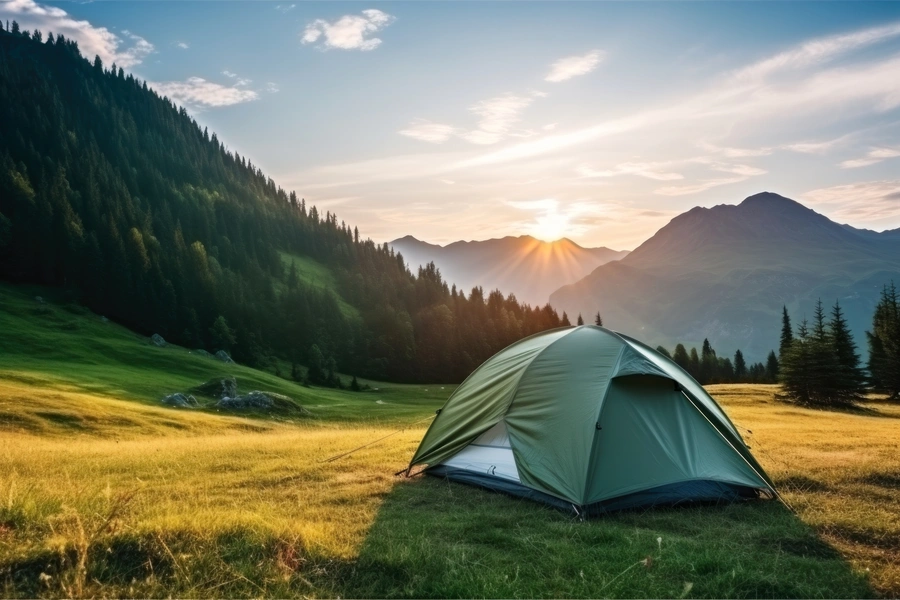Starting a camping trip begins with choosing the perfect tent, which will serve as your temporary home in the great outdoors. With a wide range of options to choose from, the task of selecting the right tent can be both daunting and exciting. The aim of this guide is to make the process easier, ensuring that you find a tent that meets your needs, preferences, and budget, ultimately enhancing your camping experience with comfort, safety, and enjoyment.
Understanding Tent Types
Dome Tents: Dome tents are known for their stability and optimal utilisation of space. These tents are distinguished by the presence of two intersecting poles, which result in a roomy interior. They are especially suitable for regular camping and brief backpacking trips, providing a blend of convenience and comfort.
Tunnel Tents: Tunnel tents, characterised by a collection of curved poles, offer ample headroom and interior space. These tents are especially suitable for family camping trips and extended stays, prioritising comfort. However, it’s important to pitch them meticulously in order to withstand powerful winds.
Geodesic and Semi-Geodesic Tents: These tents are specifically engineered for stability in demanding environments such as mountain expeditions, with poles that intersect to create triangular shapes across the surface.
Pop-Up Tents: As the name suggests, these tents literally pop into shape when unpacked, offering unparalleled ease of setup. They’re perfect for festivals and casual camping, although they may not withstand harsh weather as well as other types.
Inflatable Tents: These tents utilise inflatable beams instead of conventional poles, allowing them to be set up by simply pumping air into them. Remarkably robust and effortless to assemble, they are perfectly suited for both family camping trips and luxurious camping trips.
Key Factors to Consider
Size and Capacity: Consider how many people will typically use the tent and whether you need extra space for gear, pets, or additional room to move around comfortably. It is important to note that a “four-person tent” typically implies that it can accommodate four people sleeping side by side, with limited space for any additional items.
Weight: For backpacking tents, weight is a crucial factor. The lighter the tent, the easier it is to carry. However, this convenience often comes with a trade-off, either in terms of cost or durability. On the other hand, when it comes to car camping, the weight of the tent becomes less of a concern. In this case, you may prioritise space and comfort over the weight factor.
Seasonality
3-Season Tents: Suitable for spring, summer, and autumn, these tents are designed to keep you dry during rain and provide ventilation in warm weather.
4-Season Tents: Built to withstand harsh winter conditions, 4-season tents are more durable and offer greater protection against snow and strong winds.
Material
The durability, waterproofing, and weight of a tent are influenced by the type of fabric used. Nylon and polyester fabrics are popular choices due to their ability to strike a balance between weight and resilience. On the other hand, canvas tents made from cotton are heavier but offer excellent breathability and insulation properties.
Ease of Setup
Consider how easy the tent is to pitch, especially if you’ll be setting it up in challenging conditions or after a long day of hiking. Pop-up and inflatable tents offer the easiest setup, while traditional pole tents might require more time and effort.
Ventilation
Proper ventilation is essential to prevent condensation and ensure a comfortable sleeping environment. Look for tents with ample mesh panels and adjustable vent options.
Price
Tents can range from budget-friendly options suitable for casual use to high-end models designed for extreme conditions. Determine your budget based on how often and in what conditions you’ll be using the tent.
Additional Features
Vestibules / Porches: Useful for storing gear outside the sleeping area, keeping it dry and accessible.
Interior Pockets: Handy for organising small items within easy reach.
E-port: Allows you to run an electrical cord into the tent for power supply, useful for glamping or campsites with electrical hook-ups.
Footprint: An additional groundsheet that protects the tent floor from abrasion and moisture.
Testing and Purchase
Whenever possible, view the tent in person before buying. Many outdoor retailers will have display models set up, allowing you to get a feel for the space, layout, and quality. Additionally, online reviews and camping forums can offer valuable perspectives from seasoned users, which can further assist in making an informed decision.
Finding the perfect tent involves finding the right balance between your requirements for size, comfort, longevity, and cost. Regardless of whether you are an individual backpacker, a group of campers, or fall somewhere in the middle, there is a tent available that will perfectly suit your outdoor escapades. Dedicate some time to carefully evaluate your choices, and you will be gratified with a dependable shelter that elevates your camping endeavours for many years ahead.

